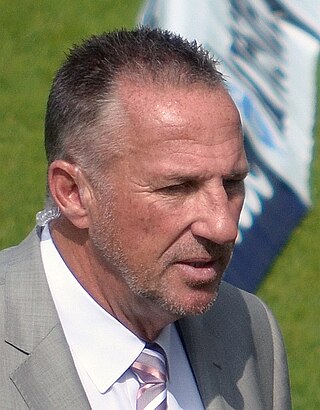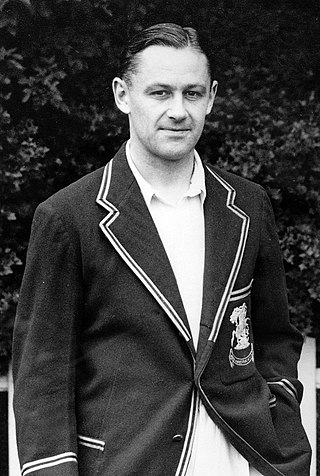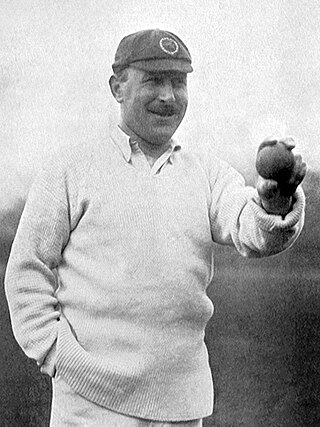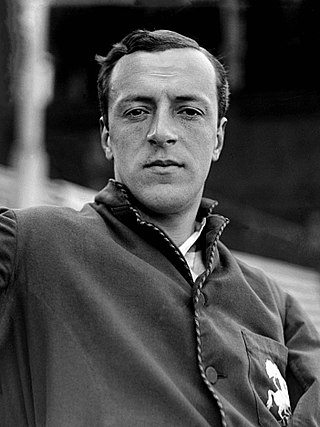
Ian Terence Botham, Baron Botham, is an English cricket commentator, member of the House of Lords, a former cricketer who has been chairman of Durham County Cricket Club since 2017 and charity fundraiser. Hailed as one of the greatest all-rounders in the history of the game, Botham represented England in both Test and One-Day International cricket.
John Augustine Snow is a retired English international cricketer who played for Sussex from 1961 to 1977 and represented England in 49 Test matches. He was born in Peopleton, Worcestershire.

Sir George Oswald Browning "Gubby" Allen CBE was a cricketer who captained England in eleven Test matches. In first-class matches, he played for Middlesex and Cambridge University. A fast bowler and hard-hitting lower-order batsman, Allen later became an influential cricket administrator who held key positions in the Marylebone Cricket Club (MCC), which effectively ruled English cricket at the time; he also served as chairman of the England selectors.

Robert George Dylan Willis was an English cricketer, who represented England between 1971 and 1984. A right-handed fast bowler, Willis is regarded by many as one of the greatest fast bowlers of all time.

Robert Peel was an English professional cricketer who played first-class cricket for Yorkshire between 1883 and 1897. Primarily a left-arm spin bowler, Peel was also an effective left-handed batsman who played in the middle order. Between 1884 and 1896, he was regularly selected to represent England, playing 20 Test matches in which he took 101 wickets. Over the course of his career, he scored 12,191 runs and took 1,775 wickets in first-class cricket. A match-winning bowler, particularly when conditions favoured his style, Peel generally opened the attack, an orthodox tactic for a spinner at the time, and was highly regarded by critics.

John William Hearne was a Middlesex leg-spinning all-rounder cricketer who played from 1909 to 1936, and represented England in 24 Test matches between 1911 and 1926.

James Michael Anderson is an English international cricketer who plays for the England Test cricket team and Lancashire, and previously played for England's limited overs cricket teams. Anderson is widely regarded as one of the greatest players of all time by English cricket fans. He holds the record for most wickets by a pace bowler in Test cricket history, having taken over 650 Test wickets.
Sir Wesley Winfield Hall is a Barbadian former cricketer and politician. A tall, strong and powerfully built man, Hall was a genuine fast bowler and despite his very long run up, he was renowned for his ability to bowl long spells. Hall played 48 Test matches for the West Indies from 1958 to 1969. Hall's opening bowling partnership with fellow Barbadian Charlie Griffith was a feature of the strong West Indies teams throughout the 1960s. Hall was one of the most popular cricketers of his day and was especially popular in Australia, where he played two seasons in the Sheffield Shield with Queensland.

George Herbert Hirst was a professional English cricketer who played first-class cricket for Yorkshire County Cricket Club between 1891 and 1921, with a further appearance in 1929. One of the best all-rounders of his time, Hirst was a left arm medium-fast bowler and right-handed batsman. He played in 24 Test matches for England between 1897 and 1909, touring Australia twice. He completed the double of 1,000 runs and 100 wickets in an English cricket season 14 times, the second most of any cricketer after his contemporary and team-mate Wilfred Rhodes. One of the Wisden Cricketers of the Year for 1901, Hirst scored 36,356 runs and took 2,742 wickets in first-class cricket. In Tests, he made 790 runs and captured 59 wickets.
The England cricket team toured Australia during the 1986–87 cricket season for a five-match Test series to contest The Ashes. While in Australia, England also played a number of tour matches against state and representative teams, and competed in two One-Day International (ODI) tournaments. Under the captaincy of Mike Gatting, England retained the Ashes with a 2–1 series win.

Frederick John Titmus was an English cricketer, whose first-class career, mostly for Middlesex with a shortish stint for Surrey, spanned five decades. He was the fourth man after W.G. Grace, Wilfred Rhodes and George Hirst to take 2,500 wickets and make 20,000 runs in first-class cricket. Although he was best known for his off-spin, he was an accomplished lower-order batsman who deserved to be called an all-rounder, even opening the batting for England on six occasions. Outside cricket, Titmus was also an able footballer; at one stage he was contracted to Watford as a professional, having earlier played for Leytonstone, and then for Chelsea as a junior.
Graham Douglas McKenzie – commonly known as "Garth", after the comic strip hero – is an Australian cricketer who played for Western Australia (1960–74), Leicestershire (1969–75), Transvaal (1979–80) and Australia (1961–71) and was a Wisden Cricketer of the Year in 1965. He succeeded Alan Davidson as Australia's premier fast bowler and was in turn succeeded by Dennis Lillee, playing with both at either end of his career. McKenzie was particularly noted for his muscular physique and ability to take wickets on good batting tracks. His father Eric McKenzie and uncle Douglas McKenzie played cricket for Western Australia and Garth was chosen for the Ashes tour of England in 1961 aged only 20. He made his debut in the Second Test at Lord's, where his 5/37 wrapped up the England innings to give Australia a 5 wicket victory.

Roy Kilner was an English professional cricketer who played nine Test matches for England between 1924 and 1926. An all-rounder, he played for Yorkshire County Cricket Club between 1911 and 1927. In all first-class matches, he scored 14,707 runs at an average of 30.01 and took 1,003 wickets at an average of 18.45. Kilner scored 1,000 runs in a season ten times and took 100 wickets in a season five times. On four occasions, he completed the double: scoring 1,000 runs and taking 100 wickets in the same season, recognised as a sign of a quality all-rounder.
Geoffrey Graham Arnold is an English cricketer who played 34 Test matches and 14 One Day Internationals for the England cricket team. His nickname of "Horse" was based on his initials of GG. He was a seam and swing bowler, who finished his first-class cricket career, which lasted from 1963 to 1982, with 1130 wickets at an average of 21.91. He played for Surrey and Sussex, winning the County Championship with the former county in 1971. He was a Wisden Cricketer of the Year in 1972.

Leonard John Coldwell was an English cricketer, who played in seven Tests for England from 1962 to 1964. Coldwell was a right-arm fast-medium bowler who was, for a few years in the early to mid-1960s, half of a respected and feared new-ball partnership in English county cricket. With his bowling partner Jack Flavell, Coldwell was the attacking force behind the unprecedented success of Worcestershire which brought the county its first successes in the County Championship in 1964 and 1965.

Philippe-Henri Edmonds is a former cricketer who represented England at international level and Middlesex at county level. After retiring he became a successful, albeit controversial, corporate executive.

Stuart Christopher John Broad is a former English cricketer who played Test cricket for the England cricket team and was One Day and Twenty20 International captain. Broad was a member of the England team that won the 2010 ICC World Twenty20. He is regarded as one of the greatest Test bowlers of all time.

Steven Thomas Finn is a former English cricketer. He was a right-arm fast bowler, who also bats right-handed. At the age of 16, he became Middlesex County Cricket Club's youngest-ever debutant in first-class cricket. He made his England Test debut in 2010 against Bangladesh. He lives in Brighton. In 2019 he became a commentator for Test Match Special.
The Indian cricket team toured England in the 1971 season and played 19 first-class fixtures, winning 7, losing only one and drawing 11.

Bernard James Tindal Bosanquet was an English cricketer best known for inventing the googly, a delivery designed to deceive the batsman. When bowled, it appears to be a leg break, but after pitching the ball turns in the opposite direction to that which is expected, behaving as an off break instead. Bosanquet, who played first-class cricket for Middlesex between 1898 and 1919, appeared in seven Test matches for England as an all-rounder. He was chosen as a Wisden Cricketer of the Year in 1905.













